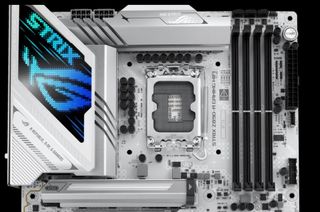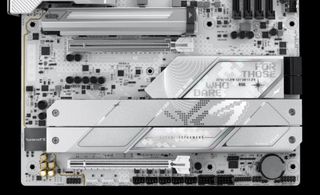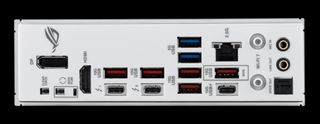Asus ROG Strix Z890-A Gaming WiFi motherboard consider: Snazzy snow owl
Our first Asus board on the Z890 platform, the ROG Strix Z890-A Gaming WiFi, is an increased mid-range class offering designed for gamers. For beneath $400, you get a slew of choices, along with all of Asus’ AI know-how (for Overclocking, Cooling, and Networking), a DIY-friendly design, a high-quality audio reply, ample storage decisions, a white aesthetic, and further.
Asus’ Z890 product stack consists of 18 motherboards on the time of this writing. All of the names you’re acquainted with are there, along with the high-end Maximus boards (Extreme and Hero), the wide-ranging Strix lineup (E/F/I Gaming), the additional budget-oriented TUF and Prime boards, ProArt sequence for Creators, and ultimately the entry-level Skilled sequence on this, the fanatic chipset. Prices range from $999.99 (Z890 Extreme) to the Prime Z890M-Plus WiFi at just under $230. Sizes range from E-ATX proper right down to MicroATX and Mini-ITX, so Asus gives one factor for everyone.
One different quintessential ROG board, the Strix Z890-A Gaming, gives clients an updated nonetheless nonetheless decidedly midrange look that retains a number of of the dot-matrix design from the ultimate period. Together with the facelift, you get sturdy vitality provide to assist flagship-class processors, 5 M.2 sockets, native Thunderbolt 4 ports, Wi-Fi 7, and further. There are only some belongings you’ll uncover missing on this board.
In our testing, the Z890-A Gaming carried out correctly whole compared with the alternative boards we’ve coated. It was a dependable gamer, carried out correctly in productiveness features, and didn’t use quite a few vitality whereas doing so. Like all of these boards in most of our exams, will most likely be exhausting to inform aside between them with out physique counters, timers, or scores.
Below, we’ll take a look at the board’s particulars and resolve whether or not or not it deserves a spot on our Biggest Motherboards guidelines. Nevertheless sooner than we share verify outcomes and speak about particulars, we’ll guidelines the specs from Asus’ site.
Specs of the Asus ROG Strix Z890-A Gaming WiFi
| Socket | Intel (LGA 1851) |
| Chipset | Z890 |
| Sort Problem | ATX |
| Voltage Regulator | 21 Part (16x 90A SPS MOSFETs for Vcore) |
| Video Ports | (2) Thunderbolt 4 (Kind-C) |
| Row 5 – Cell 0 | (1) HDMI (v2.1) |
| Row 6 – Cell 0 | (1) DisplayPort (v1.4) |
| USB Ports | (2) Thunderbolt 4 (40 Gbps) Kind-C |
| Row 8 – Cell 0 | (1) USB 3.2 Gen 2 (10 Gbps) Kind-C |
| Row 9 – Cell 0 | (5) USB 3.2 Gen 2 (10 Gbps) |
| Row 10 – Cell 0 | (2) USB 3.2 Gen 1 (5 Gbps) |
| Group Jacks | (1) 2.5 GbE |
| Audio Jacks | (2) Analog + SPDIF |
| Legacy Ports/Jacks | ✗ |
| Completely different Ports/Jack | ✗ |
| PCIe x16 | (1) v5.0 (x16) |
| Row 16 – Cell 0 | (1) v4.0 (x4) |
| PCIe x8 | ✗ |
| PCIe x4 | ✗ |
| PCIe x1 | ✗ |
| CrossFire/SLI | ??? |
| DIMM Slots | (4) DDR5-9066+(OC)*, 192GB Functionality |
| M.2 Sockets | (1) PCIe 5.0 x4 (128 Gbps) / PCIe (as a lot as 80mm) |
| Row 23 – Cell 0 | (3) PCIe 4.0 x4 (64 Gbps) / PCIe (as a lot as 80mm) |
| Row 24 – Cell 0 | (1) PCIe 4.0 x4 (64 Gbps) / PCIe+ SATA (as a lot as 80mm) |
| Row 25 – Cell 0 | Helps RAID 0/1/5/10, or 0/1/5 from CPU sockets |
| SATA Ports | (4) SATA3 6 Gbps |
| Row 27 – Cell 0 | Helps RAID 0/1/5/10 |
| USB Headers | (1) USB v3.2 Gen 2×2 (20 Gbps) Kind-C (30W PD/PPS) |
| Row 29 – Cell 0 | (1) USB v3.2 Gen 1 (5 Gbps) |
| Row 30 – Cell 0 | (1) USB v2.0 (480 Mbps) |
| Fan/Pump Headers | (8) 4-Pin (CPU, CPU OPT, AIO Pump, Chassis) |
| RGB Headers | (3) aRGB Gen 2 (3-pin) |
| Diagnostics Panel | (1) Q-LED |
| Internal Button/Change | (1) Start button |
| SATA Controllers | ✗ |
| Ethernet Controller(s) | (1) Intel i-226 (2.5 GbE) |
| Wi-Fi / Bluetooth | Wi-Fi 7 2×2- 320 MHz, 6 GHz, BT 5.4, 5.8 Gbps |
| USB Controllers | Intel JHL8440 |
| HD Audio Codec | Realtek ALC4080 w/Savitech SV3H712 Amp |
| DDL/DTS | ✗ / ✗ |
| Assure | 3 Years |
Contained within the Area of the Asus ROG Strix Z890-A Gaming WiFi
Asus incorporates quite a lot of gear to help ease your setting up experience. From SATA cables to Wi-Fi antennas, it should be ample to get you going and never utilizing a journey to the store. Below is an entire guidelines of the extras.
- Thermal pad for M.2 22110
- (2) SATA 6Gb/s cables
- ASUS WiFi Q-Antenna
- Cable ties bundle deal
- (2) M.2 Q-Latch bundle deal
- (5) M.2 rubbers
- ROG stickers/key chain
- Quick start info
Design of the Z890-A Gaming
The Strix Z890-A Gaming WiFi appears markedly utterly totally different than the Z790 mannequin. The place the sooner iteration used a black PCB and lightweight gray heatsinks/shrouds, the Z890 makes use of the sunshine gray/white PCB to match the heatsinks and shrouds for a far more cohesive look. Asus launched the polarizing dot-matrix design to the doorway proper right here, nonetheless this time spherical, it doesn’t take away from its magnificence. On prime of the VRM heatsink is the fragile Polymo lighting area with the Strix branding and the Asus ROG picture prominently featured. Asus’ Aura Sync software program program controls the built-in operate and any RGB related by the headers. Common, we just like the model new look as a result of it’s decidedly increased than the sooner mannequin and will combine in with many assemble themes, notably white ones.

Inside the left nook, we first encounter the two ProCool II (for a better match and further reliable connection) 8-pin EPS connectors to vitality the processor. The large VRM heatsinks surrounding them do an excellent job of retaining the flexibility bits beneath working inside spec. You may additionally get a better check out the Polymo lighting operate, which is ample for illuminating the inside of your chassis by itself.
Transferring correct and former the socket area, the next issue is the 4 DRAM slots with the locking mechanism on the prime. The Z890-A Gaming helps RAM functionality of as a lot as 192GB with speeds listed to DDR5-9066. The potential and speeds ought to meet an superior majority of shoppers. We had no factors working our in-house kits, along with the GSkill and Kingston 48GB DDR5-8200 CUDIMMs. As always, stick with the memory QVL guidelines for the easiest outcomes once you’re in search of to push the boundaries, though most applications should run with out downside at these speeds. The Z890-A Gaming moreover gives Asus’ DIMM Match (to optimize effectivity and pinpoint factors) and DIMM Flex (a model new choice to overclock DDR5) choices, and the AEMP III know-how to strengthen CUDIMM memory.
The first three (of eight) 4-pin fan headers are merely above that, with the alternative 5 alongside the underside edge. Each header helps PWM- and DC-controlled models nonetheless doesn’t output so much vitality. Each header helps as a lot as 1A/12W. Whereas that is ample for a lot of configurations, totally different boards present further vitality on some headers. The Armory Crate software program program suite controls these related models, as does the BIOS throughout the Q-Fan half.
Heading down the right edge, we run into the 4 Q-LEDs that light up by the POST course of. If there is a downside in considered one of many areas (CPU, DRAM, VGA, and Boot), the corresponding LED stays lit, supplying you with an considered the place the difficulty is. Below that is the Start button and the 24-pin ATX connector to vitality the board. Just below that is the doorway panel USB 3.2 Gen 2×2 Kind-C connector that doubles as your quick price port, as a lot as 30W on this board. Below that could be a 19-pin entrance panel USB 3.2 Gen 1 (5 Gbps) connection.

The VRMs on the Z890-A Gaming embrace 21 phases, 16 of which are dedicated to Vcore. Power comes from the EPS connector(s) to a Digi+ ASP2432 PWM controller. Subsequent, it strikes to the 16 Monolithic Power Packages MPS2330 90A MOSFETs throughout the acquainted “teamed” vitality configuration. The 1,4400 Amps obtainable will merely cope with overclocked flagship-class processors. As is frequent for a lot of higher-end motherboards, you’re restricted solely by your CPU cooling. This board will not stifle your ambient overclocking adventures.

On the underside half of the board, starting on the left, we see a largely uncovered audio half. Hiding beneath the Supreme FX labeled Faraday cage is a Realtek ALC4080 codec. Seen to all are the 5 yellow audio capacitors, the Savitech SV3H712 Amp, and the acquainted audio separation line. Administration over the audio half is managed by the Dolby Atmos software program program. This could be a glorious audio configuration.
The middle of the board holds two full-length PCIe slots. The best slot connects by the CPU and runs to PCIe 5.0 x16. It moreover makes use of Asus’ Safeslot for further security and the Q-Launch Slim button to secure the cardboard and allow simple elimination. The underside slot connects by the chipset and gives PCIe 4.0 x4 speeds.
Above the primary PCIe slot is the first of 5 M.2 sockets. This socket, M.2_1 (and M.2_2) be part of by the CPU. The best slot beneath the beefy heatsink with the M.2 Q-Launch latch and M.2 Q-Slide to lock your module down helps 110mm models and is your sole PCIe 5.0 x4 (128 Gbps). The second, beneath further straightforward plate heatsinks, runs at PCIe 4.0 x4 (64 Gbps) speeds. Beneath these equivalent heatsinks are three totally different M.2 sockets, all working as a lot as PCIe 4.0 x4 speeds and using M.2 Q-latch, nonetheless these be part of by the chipset. Anyone in search of to RAID these and the SATA ports are in luck. The CPU-connected sockets assist RAID 0/1/5 modes, whereas the SATA ports (found alongside the right edge) and chipset-connected models each assist RAID 0/1/5/10 modes. Must you’re concerned about lane sharing and ports dropping, do not as a result of the configuration doesn’t change it would not matter what is expounded, in line with the specs net web page and information.
All through the underside of the board are quite a lot of uncovered headers. You’ll uncover the on a regular basis stuff proper right here, along with further USB ports, RGB headers, and further. Below is an entire guidelines from left to correct.
- Entrance panel audio
- (3) 3-pin ARGB headers
- (4) System fan headers
- (2) USB 2.0 headers
- Thunderbolt 4 header
- 2-pin temperature sensor
- 2-pin chassis intrusion header

The preinstalled rear IO plate on the Z890-A Gaming Wifi has quite a few ports and buttons, nonetheless each port has easy-to-read labels in direction of a white background. On the left, we see the HDMI and DisplayPort video outputs, whereas small Clear CMOS and BIOS Flashback buttons are subsequent to them. The Intel-based 2.5 GbE and 10 USB ports are throughout the middle. You get three Kind-C ports (2x TB4/40 Gbps, 1x 10 Gbps), 5 10 Gbps Kind-A ports (purple – a sort of the BIOS Flashback port), along with two 5 Gbps Kind-A (blue). On the right are the Q-antenna connectors that merely click on on in, whereas to the right of that is the simple 2-plug audio stack (microphone and output) and SPDIF output.
MORE: Biggest Motherboards
MORE: How To Choose A Motherboard
MORE: All Motherboard Content material materials







